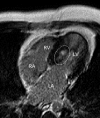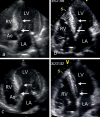The diagnosis and treatment of hypertrophic cardiomyopathy
- PMID: 21505608
- PMCID: PMC3078548
- DOI: 10.3238/arztebl.2011.0209
The diagnosis and treatment of hypertrophic cardiomyopathy
Abstract
Background: Hypertrophic cardiomyopathy (HCM) is the most common hereditary disease of the heart.
Methods: In this article, we summarize the current state of the diagnosis and treatment of HCM on the basis of a selective review of recent publications with relevance to clinical practice.
Results: Several hundred mutations in more than 27 genes, most of which encode sarcomeric structures, are associated with the HCM phenotype. Thus, HCM can be thought of as a sarcomeric disease, with myocardial fiber disarray as its histological hallmark. There are two types of HCM, a more common, obstructive type (HOCM, 70%) and a less common, non-obstructive type (HNCM; in all cases of HCM, testing should be performed to detect outflow obstruction at rest and/or on provocation, and to thereby determine whether HOCM or HNCM is present. The symptoms of HCM include dyspnea, angina pectoris, palpitations, dizziness, and occasionally syncope. Because sudden cardiac death is the most serious complication of HCM, particularly in young and asymptomatic patients, it follows that correct diagnosis, followed by risk stratification of patients with regard to the need for prophylactic implantation of an implantable cardiac defibrillator (ICD), can be of life-saving importance. The pharmacotherapy of symptomatic HNCM consists of the treatment of heart failure with a normal ejection fraction (HFNEF). In HOCM, the patient's symptoms and the obstructive gradient are the guide to treatment with beta-blockers or verapamil. For patients with drug-resistant disease, surgical myectomy and percutaneous septal ablation are now standard treatments.
Conclusion: A near-normal life expectancy and a highly satisfactory quality of life are now realistic treatment goals for patients with HCM.
Figures






References
-
- Wigle ED. Novel insights into the clinical manifestations and treatment of hypertrophic cardiomyopathy. Curr Opin Cardiol. 1995;3:299–305. - PubMed
-
- Maron BJ, Towbin JA, Thiene G, et al. American Heart Association; Council on Clinical Cardiology, Heart Failure and Transplantation Committee; Quality of Care and Outcomes Research and Functional Genomics and Translational Biology Interdisciplinary Working Groups, Council on Epidemiology and Prevention. Circulation. 2006;113:1807–1816. - PubMed
-
- Elliott P, Andersson B, Arbustini E, et al. Classification of the cardiomyopathies: a position statement from the European Society of Cardiology Working Group on Myocardial and Pericardial Diseases. Eur Heart J. 2008;29:270–276. - PubMed
-
- Bos JM, Towbin JA, Ackerman MJ. Diagnostic, prognostic, and theapeutic implications of genetic testing for hypertrophic cardiomyopathy. J Am Coll Cardiol. 2009;54:201–211. - PubMed
-
- Maron BJ, Roberts WC. Quantitative analysis of cardiac muscle cell disorganization in the ventricular septum of patients with hypertrophic cardiomyopathy. Circulation. 1979;59:689–706. - PubMed
Publication types
MeSH terms
Substances
LinkOut - more resources
Full Text Sources
Other Literature Sources

